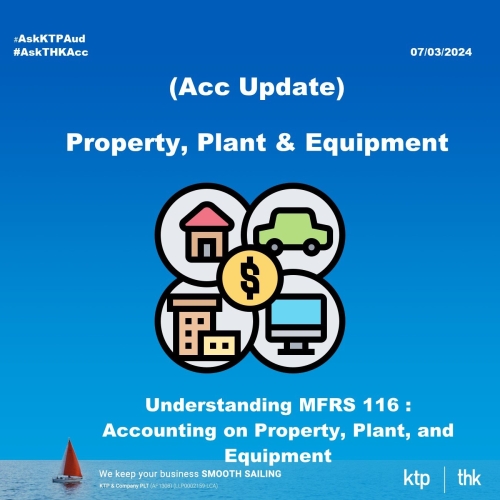(Acc Update) Understanding MFRS 116 : Accounting on Property, Plant, and Equipment
Let’s learn MFRS 116, a key accounting standard for buildings, machinery, and equipment. Uncover the crucial guidelines it establishes and understand their impact on businesses globally.
What is MFRS 116?
MFRS 116 is a rule from Malaysia on how to account for property, plants, and equipment (PPE), updating the old rule, MFRS 117.
It tells companies how to recognize PPE as assets if they think these assets will bring future benefits and if they can accurately figure out the costs. This includes adding up all costs needed to get the asset ready for use.
Main Points Explained
Recognizing Assets
MFRS 116 focuses on correctly identifying PPE assets, making sure they will likely bring future benefits and that their costs can be accurately measured. This helps keep financial reports trustworthy, letting others understand a company's assets clearly.
Measuring Costs
After an asset is recognized, its cost is calculated by taking the original cost and subtracting any depreciation (value loss over time) and losses in value. All costs directly related to getting or building the asset are included. This careful calculation helps in making smart decisions and keeps financial reports clear.
Depreciation
Depreciation spreads out the cost of an asset over its useful life. Companies must choose a depreciation method that matches how the asset's benefits are used up over time. This makes sure the asset's value in the books matches its real contribution to the business.
Revaluation
MFRS 116 lets companies adjust the book value of an asset to its current market value, but it's not required. If companies choose to do this, they need to update the values regularly. This option lets companies show the true value of their assets.
Telling Others
Companies must share detailed information about their PPE, including values, depreciation methods, and life spans. This openness helps investors and others understand the company's financial health better.
Example: Updating Equipment Value
Imagine a company with a factory that suddenly becomes more valuable because of new technology. MFRS 116 says the company should update the factory's value in their books to show its true current worth. This shows the rule's focus on keeping financial information up-to-date and reliable.
Why It Matters for Businesses
Following MFRS 116 is important for companies because it affects their financial reports, taxes, and decisions. By sticking to these rules, companies make their financial statements more believable, clear, and trustworthy. This also helps compare different companies more easily, improving analysis within and across industries.
To sum up, MFRS 116 guides businesses in accurately and transparently accounting for their buildings, machines, and equipment. Understanding and applying these rules helps businesses deal with accounting challenges confidently, earning trust from those involved.
Visit Us
-
Wisma KTP, 53 Jalan Molek 1/8, Taman Molek, 81100 Johor Bahru
-
Wisma THK, 41, Jalan Molek 1/8, Taman Molek, 81100 Johor Bahru
KTP (Audit, Tax, Advisory)
An approved audit firm and licensed tax firm operating under the KTP group based in Johor Bahru providing audit, tax planning, advisory and compliance services to clients
-
Website www.ktp.com.my
-
Instagram https://bit.ly/3Rko5kN
-
Linkedin https://bit.ly/3sapf4l
-
Telegram http://bit.ly/3ptmlpn
THK (Secretarial, Bookkeeping, Payroll, Advisory)
A licensed secretarial firm in Johor Bahru providing fast reliable incorporation, secretarial services, corporate compliance services, outsourcing bookkeeping, and payroll services to clients
-
Website www.thks.com.my
-
Facebook https://bit.ly/3nQ98rs
KTP Lifestyle
An internal community for our colleagues on work and leisure.
-
Tiktok http://bit.ly/3u9LR6Q
-
Youtube http://bit.ly/3ppmjyE
-
Facebook http://bit.ly/3ateoMz
-
Instagram https://bit.ly/3jZpKLo
KTP Career
An external job community on vacancies in Johor Bahru for interns, graduates & experienced candidates.
-
Instagram https://bit.ly/3u2PxHg
-
Facebook http://bit.ly/3rPxz9o
Published : 6-Mar-2024


